HSC 230: Health Literacy and Communication Presentation for Staff
VerifiedAdded on 2023/06/12
|8
|2587
|50
Presentation
AI Summary
This assignment consists of a presentation and written document focusing on the importance of health literacy and effective communication in healthcare, particularly within a culturally safe environment. The presentation is designed for an orientation session for new healthcare staff. It defines health literacy, discusses its benefits, and explores various health literacy frameworks. It also addresses the significance of communication in enhancing health literacy and improving patient outcomes, emphasizing the need for healthcare professionals to collaborate with patients, address cultural differences, and use clear communication strategies. The written component outlines the rationale behind the presentation, demonstrating an understanding of the topic supported by academic research and adhering to APA 6th referencing style.

Running head: HEALTH LITERACY
Presentation on health literacy and effective communication
Name of the Student
Name of the University
Author Note
Name- Student no- HSC 230 ASSESSMENT 2
Presentation on health literacy and effective communication
Name of the Student
Name of the University
Author Note
Name- Student no- HSC 230 ASSESSMENT 2
Paraphrase This Document
Need a fresh take? Get an instant paraphrase of this document with our AI Paraphraser
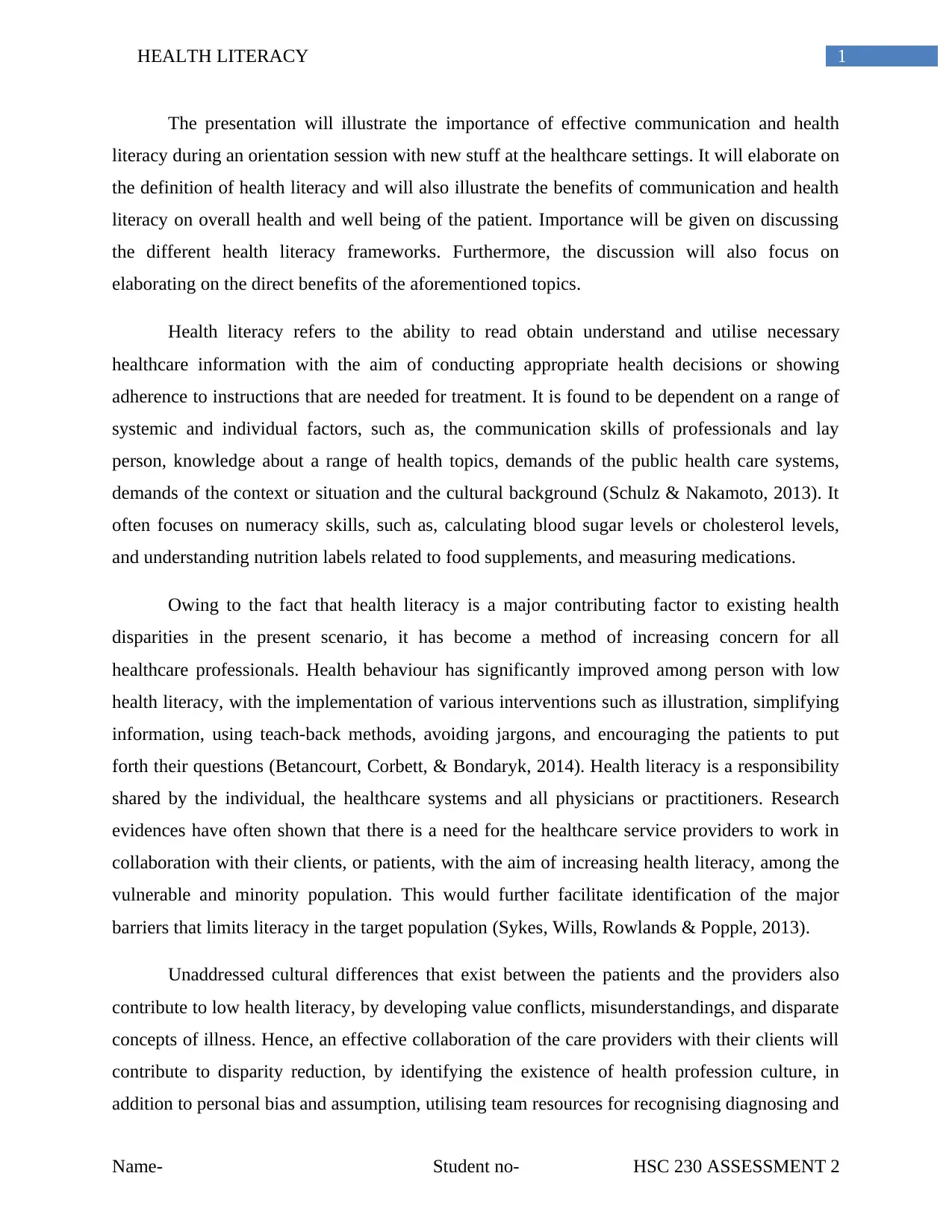
1HEALTH LITERACY
The presentation will illustrate the importance of effective communication and health
literacy during an orientation session with new stuff at the healthcare settings. It will elaborate on
the definition of health literacy and will also illustrate the benefits of communication and health
literacy on overall health and well being of the patient. Importance will be given on discussing
the different health literacy frameworks. Furthermore, the discussion will also focus on
elaborating on the direct benefits of the aforementioned topics.
Health literacy refers to the ability to read obtain understand and utilise necessary
healthcare information with the aim of conducting appropriate health decisions or showing
adherence to instructions that are needed for treatment. It is found to be dependent on a range of
systemic and individual factors, such as, the communication skills of professionals and lay
person, knowledge about a range of health topics, demands of the public health care systems,
demands of the context or situation and the cultural background (Schulz & Nakamoto, 2013). It
often focuses on numeracy skills, such as, calculating blood sugar levels or cholesterol levels,
and understanding nutrition labels related to food supplements, and measuring medications.
Owing to the fact that health literacy is a major contributing factor to existing health
disparities in the present scenario, it has become a method of increasing concern for all
healthcare professionals. Health behaviour has significantly improved among person with low
health literacy, with the implementation of various interventions such as illustration, simplifying
information, using teach-back methods, avoiding jargons, and encouraging the patients to put
forth their questions (Betancourt, Corbett, & Bondaryk, 2014). Health literacy is a responsibility
shared by the individual, the healthcare systems and all physicians or practitioners. Research
evidences have often shown that there is a need for the healthcare service providers to work in
collaboration with their clients, or patients, with the aim of increasing health literacy, among the
vulnerable and minority population. This would further facilitate identification of the major
barriers that limits literacy in the target population (Sykes, Wills, Rowlands & Popple, 2013).
Unaddressed cultural differences that exist between the patients and the providers also
contribute to low health literacy, by developing value conflicts, misunderstandings, and disparate
concepts of illness. Hence, an effective collaboration of the care providers with their clients will
contribute to disparity reduction, by identifying the existence of health profession culture, in
addition to personal bias and assumption, utilising team resources for recognising diagnosing and
Name- Student no- HSC 230 ASSESSMENT 2
The presentation will illustrate the importance of effective communication and health
literacy during an orientation session with new stuff at the healthcare settings. It will elaborate on
the definition of health literacy and will also illustrate the benefits of communication and health
literacy on overall health and well being of the patient. Importance will be given on discussing
the different health literacy frameworks. Furthermore, the discussion will also focus on
elaborating on the direct benefits of the aforementioned topics.
Health literacy refers to the ability to read obtain understand and utilise necessary
healthcare information with the aim of conducting appropriate health decisions or showing
adherence to instructions that are needed for treatment. It is found to be dependent on a range of
systemic and individual factors, such as, the communication skills of professionals and lay
person, knowledge about a range of health topics, demands of the public health care systems,
demands of the context or situation and the cultural background (Schulz & Nakamoto, 2013). It
often focuses on numeracy skills, such as, calculating blood sugar levels or cholesterol levels,
and understanding nutrition labels related to food supplements, and measuring medications.
Owing to the fact that health literacy is a major contributing factor to existing health
disparities in the present scenario, it has become a method of increasing concern for all
healthcare professionals. Health behaviour has significantly improved among person with low
health literacy, with the implementation of various interventions such as illustration, simplifying
information, using teach-back methods, avoiding jargons, and encouraging the patients to put
forth their questions (Betancourt, Corbett, & Bondaryk, 2014). Health literacy is a responsibility
shared by the individual, the healthcare systems and all physicians or practitioners. Research
evidences have often shown that there is a need for the healthcare service providers to work in
collaboration with their clients, or patients, with the aim of increasing health literacy, among the
vulnerable and minority population. This would further facilitate identification of the major
barriers that limits literacy in the target population (Sykes, Wills, Rowlands & Popple, 2013).
Unaddressed cultural differences that exist between the patients and the providers also
contribute to low health literacy, by developing value conflicts, misunderstandings, and disparate
concepts of illness. Hence, an effective collaboration of the care providers with their clients will
contribute to disparity reduction, by identifying the existence of health profession culture, in
addition to personal bias and assumption, utilising team resources for recognising diagnosing and
Name- Student no- HSC 230 ASSESSMENT 2
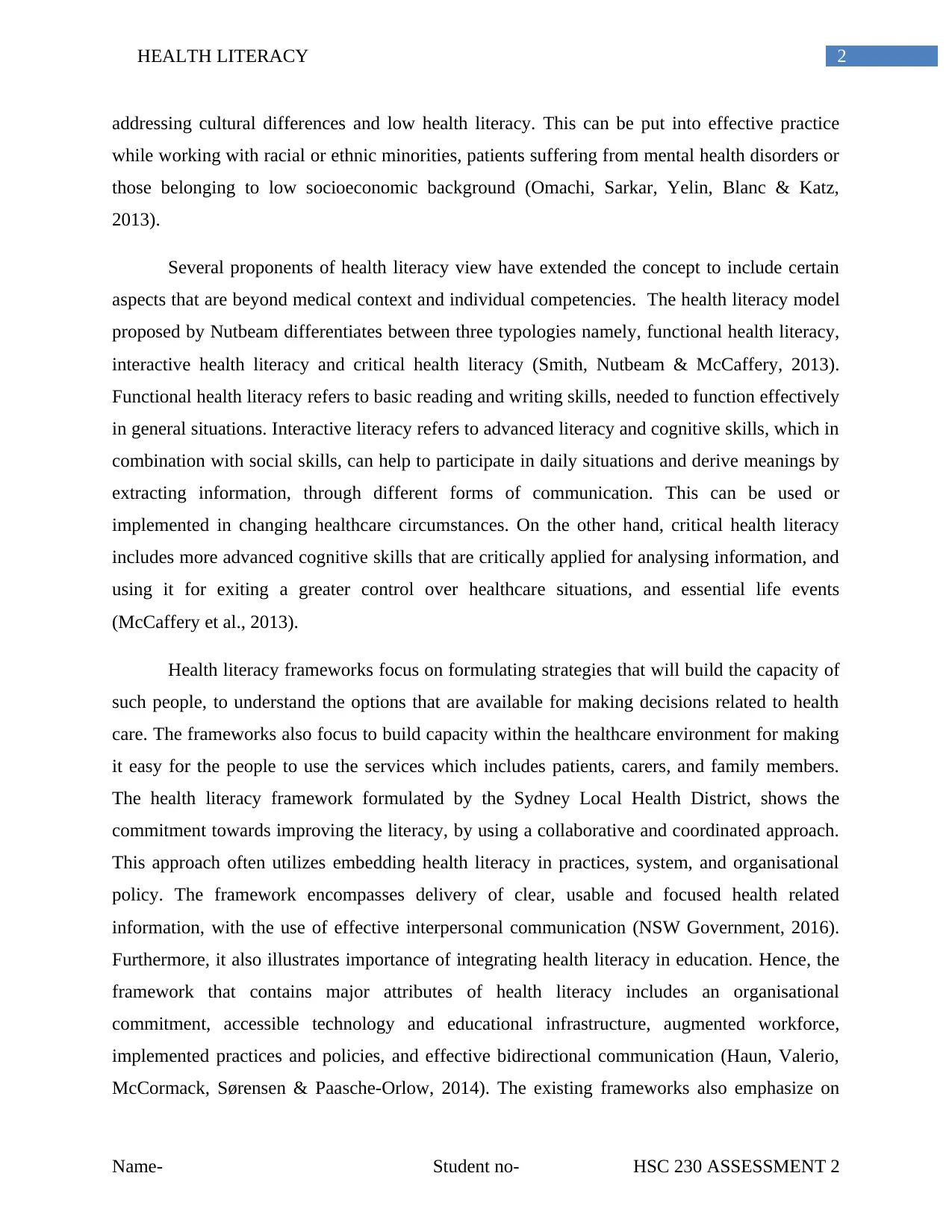
2HEALTH LITERACY
addressing cultural differences and low health literacy. This can be put into effective practice
while working with racial or ethnic minorities, patients suffering from mental health disorders or
those belonging to low socioeconomic background (Omachi, Sarkar, Yelin, Blanc & Katz,
2013).
Several proponents of health literacy view have extended the concept to include certain
aspects that are beyond medical context and individual competencies. The health literacy model
proposed by Nutbeam differentiates between three typologies namely, functional health literacy,
interactive health literacy and critical health literacy (Smith, Nutbeam & McCaffery, 2013).
Functional health literacy refers to basic reading and writing skills, needed to function effectively
in general situations. Interactive literacy refers to advanced literacy and cognitive skills, which in
combination with social skills, can help to participate in daily situations and derive meanings by
extracting information, through different forms of communication. This can be used or
implemented in changing healthcare circumstances. On the other hand, critical health literacy
includes more advanced cognitive skills that are critically applied for analysing information, and
using it for exiting a greater control over healthcare situations, and essential life events
(McCaffery et al., 2013).
Health literacy frameworks focus on formulating strategies that will build the capacity of
such people, to understand the options that are available for making decisions related to health
care. The frameworks also focus to build capacity within the healthcare environment for making
it easy for the people to use the services which includes patients, carers, and family members.
The health literacy framework formulated by the Sydney Local Health District, shows the
commitment towards improving the literacy, by using a collaborative and coordinated approach.
This approach often utilizes embedding health literacy in practices, system, and organisational
policy. The framework encompasses delivery of clear, usable and focused health related
information, with the use of effective interpersonal communication (NSW Government, 2016).
Furthermore, it also illustrates importance of integrating health literacy in education. Hence, the
framework that contains major attributes of health literacy includes an organisational
commitment, accessible technology and educational infrastructure, augmented workforce,
implemented practices and policies, and effective bidirectional communication (Haun, Valerio,
McCormack, Sørensen & Paasche-Orlow, 2014). The existing frameworks also emphasize on
Name- Student no- HSC 230 ASSESSMENT 2
addressing cultural differences and low health literacy. This can be put into effective practice
while working with racial or ethnic minorities, patients suffering from mental health disorders or
those belonging to low socioeconomic background (Omachi, Sarkar, Yelin, Blanc & Katz,
2013).
Several proponents of health literacy view have extended the concept to include certain
aspects that are beyond medical context and individual competencies. The health literacy model
proposed by Nutbeam differentiates between three typologies namely, functional health literacy,
interactive health literacy and critical health literacy (Smith, Nutbeam & McCaffery, 2013).
Functional health literacy refers to basic reading and writing skills, needed to function effectively
in general situations. Interactive literacy refers to advanced literacy and cognitive skills, which in
combination with social skills, can help to participate in daily situations and derive meanings by
extracting information, through different forms of communication. This can be used or
implemented in changing healthcare circumstances. On the other hand, critical health literacy
includes more advanced cognitive skills that are critically applied for analysing information, and
using it for exiting a greater control over healthcare situations, and essential life events
(McCaffery et al., 2013).
Health literacy frameworks focus on formulating strategies that will build the capacity of
such people, to understand the options that are available for making decisions related to health
care. The frameworks also focus to build capacity within the healthcare environment for making
it easy for the people to use the services which includes patients, carers, and family members.
The health literacy framework formulated by the Sydney Local Health District, shows the
commitment towards improving the literacy, by using a collaborative and coordinated approach.
This approach often utilizes embedding health literacy in practices, system, and organisational
policy. The framework encompasses delivery of clear, usable and focused health related
information, with the use of effective interpersonal communication (NSW Government, 2016).
Furthermore, it also illustrates importance of integrating health literacy in education. Hence, the
framework that contains major attributes of health literacy includes an organisational
commitment, accessible technology and educational infrastructure, augmented workforce,
implemented practices and policies, and effective bidirectional communication (Haun, Valerio,
McCormack, Sørensen & Paasche-Orlow, 2014). The existing frameworks also emphasize on
Name- Student no- HSC 230 ASSESSMENT 2
⊘ This is a preview!⊘
Do you want full access?
Subscribe today to unlock all pages.

Trusted by 1+ million students worldwide
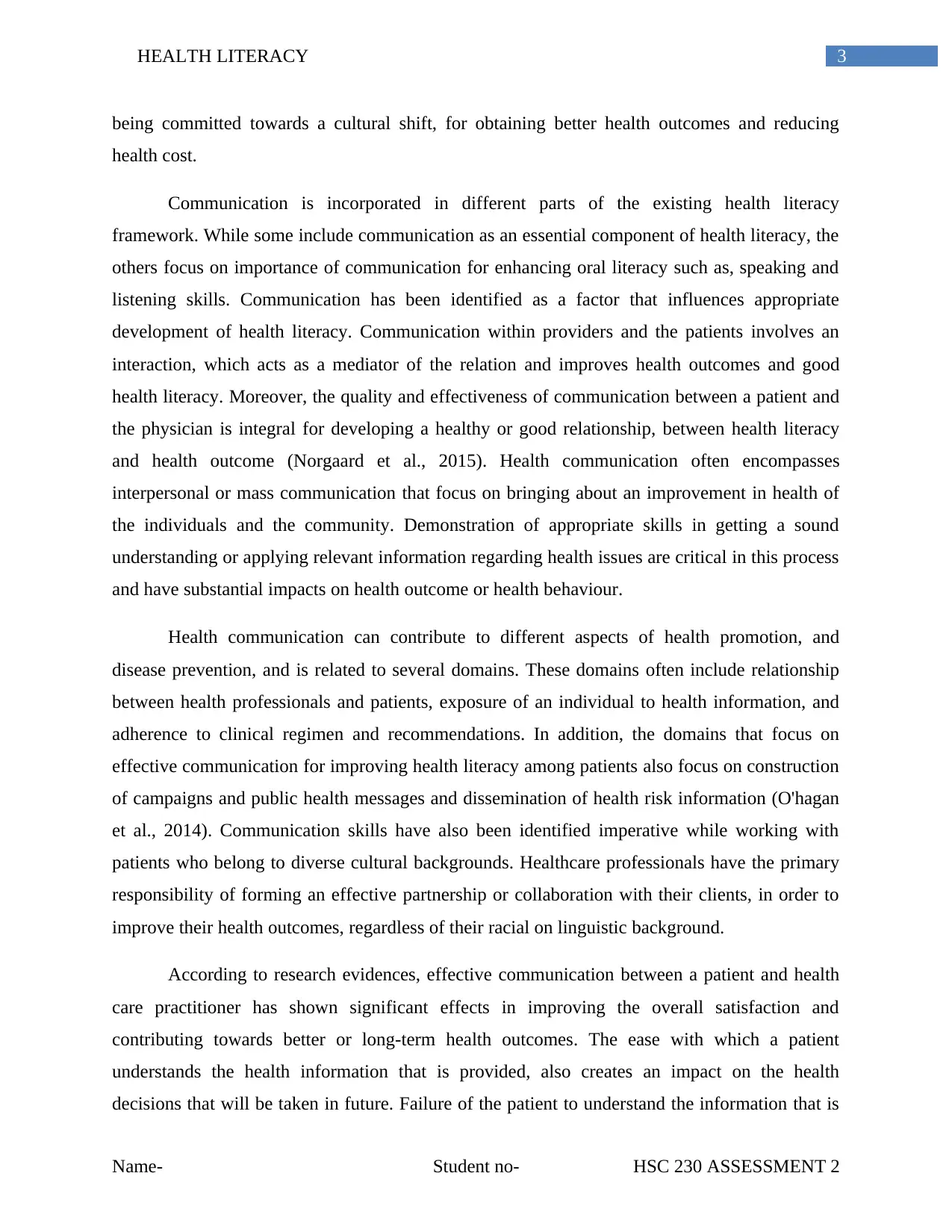
3HEALTH LITERACY
being committed towards a cultural shift, for obtaining better health outcomes and reducing
health cost.
Communication is incorporated in different parts of the existing health literacy
framework. While some include communication as an essential component of health literacy, the
others focus on importance of communication for enhancing oral literacy such as, speaking and
listening skills. Communication has been identified as a factor that influences appropriate
development of health literacy. Communication within providers and the patients involves an
interaction, which acts as a mediator of the relation and improves health outcomes and good
health literacy. Moreover, the quality and effectiveness of communication between a patient and
the physician is integral for developing a healthy or good relationship, between health literacy
and health outcome (Norgaard et al., 2015). Health communication often encompasses
interpersonal or mass communication that focus on bringing about an improvement in health of
the individuals and the community. Demonstration of appropriate skills in getting a sound
understanding or applying relevant information regarding health issues are critical in this process
and have substantial impacts on health outcome or health behaviour.
Health communication can contribute to different aspects of health promotion, and
disease prevention, and is related to several domains. These domains often include relationship
between health professionals and patients, exposure of an individual to health information, and
adherence to clinical regimen and recommendations. In addition, the domains that focus on
effective communication for improving health literacy among patients also focus on construction
of campaigns and public health messages and dissemination of health risk information (O'hagan
et al., 2014). Communication skills have also been identified imperative while working with
patients who belong to diverse cultural backgrounds. Healthcare professionals have the primary
responsibility of forming an effective partnership or collaboration with their clients, in order to
improve their health outcomes, regardless of their racial on linguistic background.
According to research evidences, effective communication between a patient and health
care practitioner has shown significant effects in improving the overall satisfaction and
contributing towards better or long-term health outcomes. The ease with which a patient
understands the health information that is provided, also creates an impact on the health
decisions that will be taken in future. Failure of the patient to understand the information that is
Name- Student no- HSC 230 ASSESSMENT 2
being committed towards a cultural shift, for obtaining better health outcomes and reducing
health cost.
Communication is incorporated in different parts of the existing health literacy
framework. While some include communication as an essential component of health literacy, the
others focus on importance of communication for enhancing oral literacy such as, speaking and
listening skills. Communication has been identified as a factor that influences appropriate
development of health literacy. Communication within providers and the patients involves an
interaction, which acts as a mediator of the relation and improves health outcomes and good
health literacy. Moreover, the quality and effectiveness of communication between a patient and
the physician is integral for developing a healthy or good relationship, between health literacy
and health outcome (Norgaard et al., 2015). Health communication often encompasses
interpersonal or mass communication that focus on bringing about an improvement in health of
the individuals and the community. Demonstration of appropriate skills in getting a sound
understanding or applying relevant information regarding health issues are critical in this process
and have substantial impacts on health outcome or health behaviour.
Health communication can contribute to different aspects of health promotion, and
disease prevention, and is related to several domains. These domains often include relationship
between health professionals and patients, exposure of an individual to health information, and
adherence to clinical regimen and recommendations. In addition, the domains that focus on
effective communication for improving health literacy among patients also focus on construction
of campaigns and public health messages and dissemination of health risk information (O'hagan
et al., 2014). Communication skills have also been identified imperative while working with
patients who belong to diverse cultural backgrounds. Healthcare professionals have the primary
responsibility of forming an effective partnership or collaboration with their clients, in order to
improve their health outcomes, regardless of their racial on linguistic background.
According to research evidences, effective communication between a patient and health
care practitioner has shown significant effects in improving the overall satisfaction and
contributing towards better or long-term health outcomes. The ease with which a patient
understands the health information that is provided, also creates an impact on the health
decisions that will be taken in future. Failure of the patient to understand the information that is
Name- Student no- HSC 230 ASSESSMENT 2
Paraphrase This Document
Need a fresh take? Get an instant paraphrase of this document with our AI Paraphraser
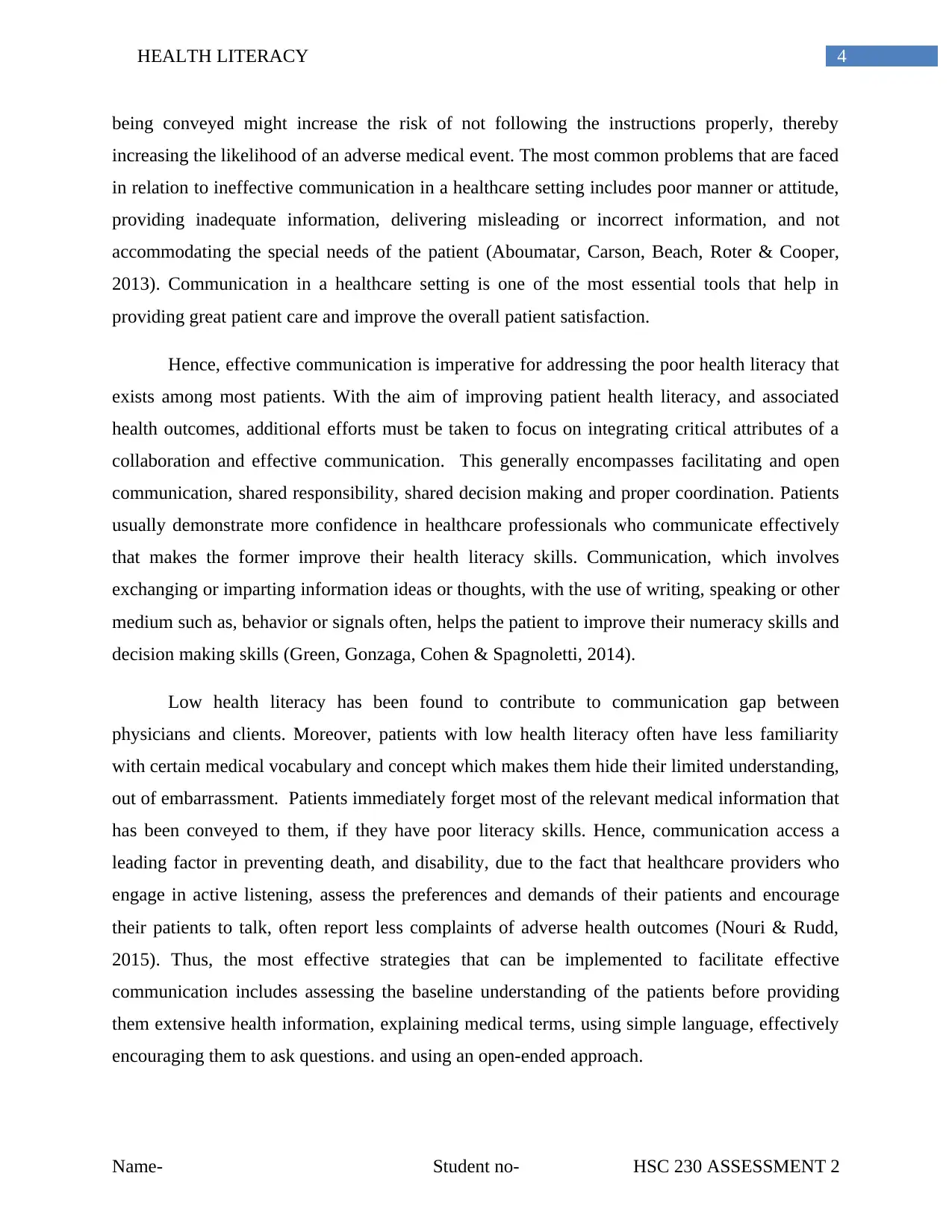
4HEALTH LITERACY
being conveyed might increase the risk of not following the instructions properly, thereby
increasing the likelihood of an adverse medical event. The most common problems that are faced
in relation to ineffective communication in a healthcare setting includes poor manner or attitude,
providing inadequate information, delivering misleading or incorrect information, and not
accommodating the special needs of the patient (Aboumatar, Carson, Beach, Roter & Cooper,
2013). Communication in a healthcare setting is one of the most essential tools that help in
providing great patient care and improve the overall patient satisfaction.
Hence, effective communication is imperative for addressing the poor health literacy that
exists among most patients. With the aim of improving patient health literacy, and associated
health outcomes, additional efforts must be taken to focus on integrating critical attributes of a
collaboration and effective communication. This generally encompasses facilitating and open
communication, shared responsibility, shared decision making and proper coordination. Patients
usually demonstrate more confidence in healthcare professionals who communicate effectively
that makes the former improve their health literacy skills. Communication, which involves
exchanging or imparting information ideas or thoughts, with the use of writing, speaking or other
medium such as, behavior or signals often, helps the patient to improve their numeracy skills and
decision making skills (Green, Gonzaga, Cohen & Spagnoletti, 2014).
Low health literacy has been found to contribute to communication gap between
physicians and clients. Moreover, patients with low health literacy often have less familiarity
with certain medical vocabulary and concept which makes them hide their limited understanding,
out of embarrassment. Patients immediately forget most of the relevant medical information that
has been conveyed to them, if they have poor literacy skills. Hence, communication access a
leading factor in preventing death, and disability, due to the fact that healthcare providers who
engage in active listening, assess the preferences and demands of their patients and encourage
their patients to talk, often report less complaints of adverse health outcomes (Nouri & Rudd,
2015). Thus, the most effective strategies that can be implemented to facilitate effective
communication includes assessing the baseline understanding of the patients before providing
them extensive health information, explaining medical terms, using simple language, effectively
encouraging them to ask questions. and using an open-ended approach.
Name- Student no- HSC 230 ASSESSMENT 2
being conveyed might increase the risk of not following the instructions properly, thereby
increasing the likelihood of an adverse medical event. The most common problems that are faced
in relation to ineffective communication in a healthcare setting includes poor manner or attitude,
providing inadequate information, delivering misleading or incorrect information, and not
accommodating the special needs of the patient (Aboumatar, Carson, Beach, Roter & Cooper,
2013). Communication in a healthcare setting is one of the most essential tools that help in
providing great patient care and improve the overall patient satisfaction.
Hence, effective communication is imperative for addressing the poor health literacy that
exists among most patients. With the aim of improving patient health literacy, and associated
health outcomes, additional efforts must be taken to focus on integrating critical attributes of a
collaboration and effective communication. This generally encompasses facilitating and open
communication, shared responsibility, shared decision making and proper coordination. Patients
usually demonstrate more confidence in healthcare professionals who communicate effectively
that makes the former improve their health literacy skills. Communication, which involves
exchanging or imparting information ideas or thoughts, with the use of writing, speaking or other
medium such as, behavior or signals often, helps the patient to improve their numeracy skills and
decision making skills (Green, Gonzaga, Cohen & Spagnoletti, 2014).
Low health literacy has been found to contribute to communication gap between
physicians and clients. Moreover, patients with low health literacy often have less familiarity
with certain medical vocabulary and concept which makes them hide their limited understanding,
out of embarrassment. Patients immediately forget most of the relevant medical information that
has been conveyed to them, if they have poor literacy skills. Hence, communication access a
leading factor in preventing death, and disability, due to the fact that healthcare providers who
engage in active listening, assess the preferences and demands of their patients and encourage
their patients to talk, often report less complaints of adverse health outcomes (Nouri & Rudd,
2015). Thus, the most effective strategies that can be implemented to facilitate effective
communication includes assessing the baseline understanding of the patients before providing
them extensive health information, explaining medical terms, using simple language, effectively
encouraging them to ask questions. and using an open-ended approach.
Name- Student no- HSC 230 ASSESSMENT 2

5HEALTH LITERACY
To conclude, health literacy is integral or critical to empowerment due to the fact that it
improves the ability of all patients to access and use necessary healthcare information and also
enhance their capability to use it in an effective manner. Thus, it can be stated that a combination
of several skills that include writing, reading, speaking, listening, critical analysis,
communication, and numeracy are imperative for demonstration of appropriate health literacy.
Name- Student no- HSC 230 ASSESSMENT 2
To conclude, health literacy is integral or critical to empowerment due to the fact that it
improves the ability of all patients to access and use necessary healthcare information and also
enhance their capability to use it in an effective manner. Thus, it can be stated that a combination
of several skills that include writing, reading, speaking, listening, critical analysis,
communication, and numeracy are imperative for demonstration of appropriate health literacy.
Name- Student no- HSC 230 ASSESSMENT 2
⊘ This is a preview!⊘
Do you want full access?
Subscribe today to unlock all pages.

Trusted by 1+ million students worldwide

6HEALTH LITERACY
References
Aboumatar, H. J., Carson, K. A., Beach, M. C., Roter, D. L., & Cooper, L. A. (2013). The impact
of health literacy on desire for participation in healthcare, medical visit communication,
and patient reported outcomes among patients with hypertension. Journal of general
internal medicine, 28(11), 1469-1476. https://doi.org/10.1007/s11606-013-2466-5
Betancourt, J. R., Corbett, J., & Bondaryk, M. R. (2014). Addressing disparities and achieving
equity: cultural competence, ethics, and health-care transformation. Chest, 145(1), 143-
148. https://doi.org/10.1378/chest.13-0634
Green, J. A., Gonzaga, A. M., Cohen, E. D., & Spagnoletti, C. L. (2014). Addressing health
literacy through clear health communication: a training program for internal medicine
residents. Patient education and counseling, 95(1), 76-82.
https://doi.org/10.1016/j.pec.2014.01.004
Haun, J. N., Valerio, M. A., McCormack, L. A., Sørensen, K., & Paasche-Orlow, M. K. (2014).
Health literacy measurement: an inventory and descriptive summary of 51
instruments. Journal of Health Communication, 19(sup2), 302-333.
https://doi.org/10.1080/10810730.2014.936571
McCaffery, K. J., Holmes-Rovner, M., Smith, S. K., Rovner, D., Nutbeam, D., Clayman, M.
L., ... & Sheridan, S. L. (2013). Addressing health literacy in patient decision aids. BMC
medical informatics and decision making, 13(2), S10. https://doi.org/10.1186/1472-6947-
13-S2-S10
Norgaard, O., Furstrand, D., Klokker, L., Karnoe, A., Batterham, R., Kayser, L., & Osborne, R.
H. (2015). The e-health literacy framework: a conceptual framework for characterizing e-
health users and their interaction with e-health systems. Knowledge Management & E-
Learning: An International Journal (KM&EL), 7(4), 522-540. Retrieved from-
http://cdrwww.who.int/global-coordination-mechanism/working-groups/elearn_hl.pdf
Nouri, S. S., & Rudd, R. E. (2015). Health literacy in the “oral exchange”: An important element
of patient–provider communication. Patient education and counseling, 98(5), 565-571.
https://doi.org/10.1016/j.pec.2014.12.002
Name- Student no- HSC 230 ASSESSMENT 2
References
Aboumatar, H. J., Carson, K. A., Beach, M. C., Roter, D. L., & Cooper, L. A. (2013). The impact
of health literacy on desire for participation in healthcare, medical visit communication,
and patient reported outcomes among patients with hypertension. Journal of general
internal medicine, 28(11), 1469-1476. https://doi.org/10.1007/s11606-013-2466-5
Betancourt, J. R., Corbett, J., & Bondaryk, M. R. (2014). Addressing disparities and achieving
equity: cultural competence, ethics, and health-care transformation. Chest, 145(1), 143-
148. https://doi.org/10.1378/chest.13-0634
Green, J. A., Gonzaga, A. M., Cohen, E. D., & Spagnoletti, C. L. (2014). Addressing health
literacy through clear health communication: a training program for internal medicine
residents. Patient education and counseling, 95(1), 76-82.
https://doi.org/10.1016/j.pec.2014.01.004
Haun, J. N., Valerio, M. A., McCormack, L. A., Sørensen, K., & Paasche-Orlow, M. K. (2014).
Health literacy measurement: an inventory and descriptive summary of 51
instruments. Journal of Health Communication, 19(sup2), 302-333.
https://doi.org/10.1080/10810730.2014.936571
McCaffery, K. J., Holmes-Rovner, M., Smith, S. K., Rovner, D., Nutbeam, D., Clayman, M.
L., ... & Sheridan, S. L. (2013). Addressing health literacy in patient decision aids. BMC
medical informatics and decision making, 13(2), S10. https://doi.org/10.1186/1472-6947-
13-S2-S10
Norgaard, O., Furstrand, D., Klokker, L., Karnoe, A., Batterham, R., Kayser, L., & Osborne, R.
H. (2015). The e-health literacy framework: a conceptual framework for characterizing e-
health users and their interaction with e-health systems. Knowledge Management & E-
Learning: An International Journal (KM&EL), 7(4), 522-540. Retrieved from-
http://cdrwww.who.int/global-coordination-mechanism/working-groups/elearn_hl.pdf
Nouri, S. S., & Rudd, R. E. (2015). Health literacy in the “oral exchange”: An important element
of patient–provider communication. Patient education and counseling, 98(5), 565-571.
https://doi.org/10.1016/j.pec.2014.12.002
Name- Student no- HSC 230 ASSESSMENT 2
Paraphrase This Document
Need a fresh take? Get an instant paraphrase of this document with our AI Paraphraser
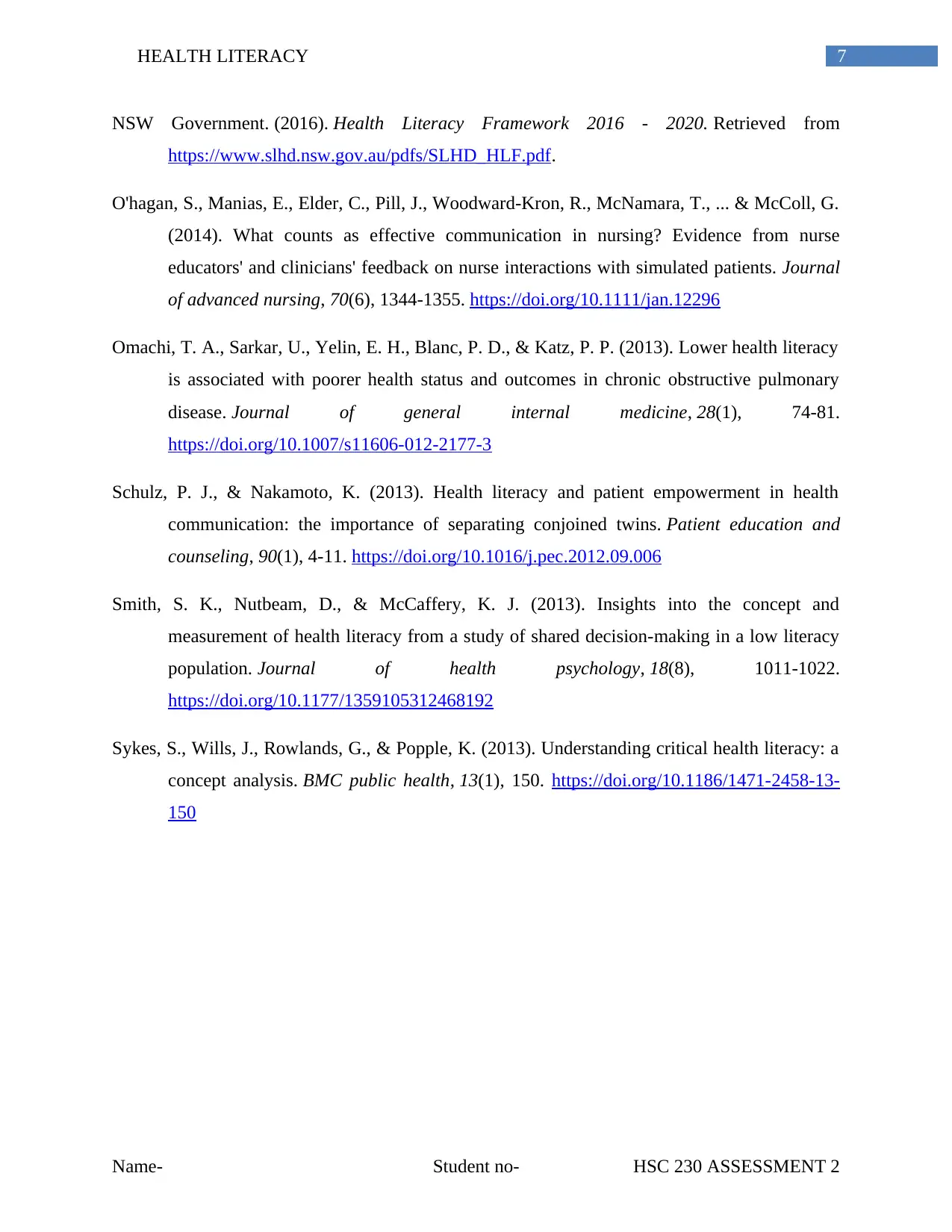
7HEALTH LITERACY
NSW Government. (2016). Health Literacy Framework 2016 - 2020. Retrieved from
https://www.slhd.nsw.gov.au/pdfs/SLHD_HLF.pdf.
O'hagan, S., Manias, E., Elder, C., Pill, J., Woodward‐Kron, R., McNamara, T., ... & McColl, G.
(2014). What counts as effective communication in nursing? Evidence from nurse
educators' and clinicians' feedback on nurse interactions with simulated patients. Journal
of advanced nursing, 70(6), 1344-1355. https://doi.org/10.1111/jan.12296
Omachi, T. A., Sarkar, U., Yelin, E. H., Blanc, P. D., & Katz, P. P. (2013). Lower health literacy
is associated with poorer health status and outcomes in chronic obstructive pulmonary
disease. Journal of general internal medicine, 28(1), 74-81.
https://doi.org/10.1007/s11606-012-2177-3
Schulz, P. J., & Nakamoto, K. (2013). Health literacy and patient empowerment in health
communication: the importance of separating conjoined twins. Patient education and
counseling, 90(1), 4-11. https://doi.org/10.1016/j.pec.2012.09.006
Smith, S. K., Nutbeam, D., & McCaffery, K. J. (2013). Insights into the concept and
measurement of health literacy from a study of shared decision-making in a low literacy
population. Journal of health psychology, 18(8), 1011-1022.
https://doi.org/10.1177/1359105312468192
Sykes, S., Wills, J., Rowlands, G., & Popple, K. (2013). Understanding critical health literacy: a
concept analysis. BMC public health, 13(1), 150. https://doi.org/10.1186/1471-2458-13-
150
Name- Student no- HSC 230 ASSESSMENT 2
NSW Government. (2016). Health Literacy Framework 2016 - 2020. Retrieved from
https://www.slhd.nsw.gov.au/pdfs/SLHD_HLF.pdf.
O'hagan, S., Manias, E., Elder, C., Pill, J., Woodward‐Kron, R., McNamara, T., ... & McColl, G.
(2014). What counts as effective communication in nursing? Evidence from nurse
educators' and clinicians' feedback on nurse interactions with simulated patients. Journal
of advanced nursing, 70(6), 1344-1355. https://doi.org/10.1111/jan.12296
Omachi, T. A., Sarkar, U., Yelin, E. H., Blanc, P. D., & Katz, P. P. (2013). Lower health literacy
is associated with poorer health status and outcomes in chronic obstructive pulmonary
disease. Journal of general internal medicine, 28(1), 74-81.
https://doi.org/10.1007/s11606-012-2177-3
Schulz, P. J., & Nakamoto, K. (2013). Health literacy and patient empowerment in health
communication: the importance of separating conjoined twins. Patient education and
counseling, 90(1), 4-11. https://doi.org/10.1016/j.pec.2012.09.006
Smith, S. K., Nutbeam, D., & McCaffery, K. J. (2013). Insights into the concept and
measurement of health literacy from a study of shared decision-making in a low literacy
population. Journal of health psychology, 18(8), 1011-1022.
https://doi.org/10.1177/1359105312468192
Sykes, S., Wills, J., Rowlands, G., & Popple, K. (2013). Understanding critical health literacy: a
concept analysis. BMC public health, 13(1), 150. https://doi.org/10.1186/1471-2458-13-
150
Name- Student no- HSC 230 ASSESSMENT 2
1 out of 8
Related Documents
Your All-in-One AI-Powered Toolkit for Academic Success.
+13062052269
info@desklib.com
Available 24*7 on WhatsApp / Email
![[object Object]](/_next/static/media/star-bottom.7253800d.svg)
Unlock your academic potential
Copyright © 2020–2025 A2Z Services. All Rights Reserved. Developed and managed by ZUCOL.




